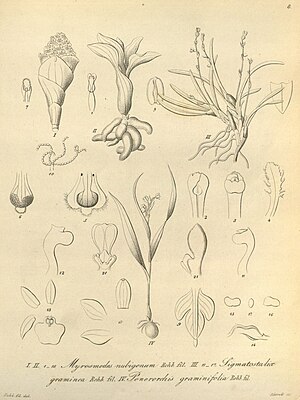Myrosmodes
| Myrosmodes | ||||||||||||
|---|---|---|---|---|---|---|---|---|---|---|---|---|

Illustration of Myrosmodes nubigena , top left, Figs. I and II |
||||||||||||
| Systematics | ||||||||||||
|
||||||||||||
| Scientific name | ||||||||||||
| Myrosmodes | ||||||||||||
| Rchb.f. |
Myrosmodes is a genus from the family of the orchid (Orchidaceae). It consists of twelve types of herbaceous plants that are native to South America.
description
The species of the genus Myrosmodes are terrestrial, small herbaceous plants. The roots , which arise close together, are fleshy, spindle-shaped and mostly hairy. The leaves are in a basal rosette, they only develop after the flowering period. The small leaves are oval and short-stalked, often of a fleshy texture.
The racemose, many-flowered inflorescence is lateral, upright. The peduncle is encased by bracts that overlap strongly. The bracts are shorter than the flowers. The flowers are rather small, hairless, they are usually close together and are not resupinated . The three sepals are shaped roughly the same as each other, fused together for a few millimeters at the base. The petals are much narrower. The dorsal sepal and the lateral petals are attached to the base of the column . The lip is tubular or spread out, tapering to a wedge shape at the base, with indistinct calluses on the blade, fringed on the edge. The column is short and hairless. The scar is large and bean-shaped. The stamen is almost completely enclosed by a lobed tissue of the column (clinandrium). The stamen contains four pollinia , which sit on a glutinous gland (Viscidium) without a stalk. The rostellum between stigma and stamen lies transversely to the columnar axis, it ends bluntly or lobed.
As pollinators was at myrosmodes rhynchocarpa the solitary wasp wrinkles Incodynerus romandinus observed.
Occurrence
Myrosmodes occurs in western South America, in the Andes from Venezuela to Argentina. They are pronounced high mountain plants, the genus inhabits altitudes of 3800 to 4600 meters. The locations are often in damp places, such as in swamps and streams. Is associated myrosmodes often with Azorella .
Systematics and botanical history
The genus Myrosmodes was established by Reichenbach in 1854 . The name is derived from the Greek μύρον myron for "aromatic oil", ὀσμή osme for "fragrance" and the syllable ὄδη -odes , "equal"; it refers to the fragrant flowers. The type species is Myrosmodes nubigena .
Myrosmodes is classified within the tribe Cranichideae in the subtribe Cranichidinae . The genera Aa and Porphyrostachys are closely related .
There are 14 known species:
- Myrosmodes brevis (Schltr.) Garay : It occurs in Ecuador and Peru.
- Myrosmodes chiogena (Schltr.) CAVargas : It occurs in Peru and Bolivia.
- Myrosmodes cleefii Szlach., Mytnik & S.Nowak : The species first described in 2012 occurs in Colombia.
- Myrosmodes cochlearis Garay : It occurs from western South America to northwestern Venezuela.
- Myrosmodes filamentosa (Mansf.) Garay : It occurs in Ecuador.
- Myrosmodes gymnandra (Rchb.f.) CAVargas (Syn .: Myrosmodes weberbaueri (Schltr.) CAVargas ): It occurs from Peru to Argentina.
- Myrosmodes nervosa (Kraenzl.) Novoa, CAVargas & Cisternas : It occurs from southern Peru to northern Chile.
- Myrosmodes nubigena Rchb.f. : It occurs from northwestern Venezuela to western South America.
- Myrosmodes paludosa (Rchb.f.) P.Ortiz : It occurs from Bolivia to Peru.
- Myrosmodes reticulata Szlach., Mytnik & S.Nowak : It occurs in Colombia.
- Myrosmodes rhynchocarpa (Schltr.) Garay : It occurs from Colombia to Ecuador.
- Myrosmodes rostrata (Rchb.f.) Garay : It occurs in Colombia, Ecuador and western Bolivia.
- Myrosmodes subnivalis Szlach., Mytnik & S.Nowak : The species first described in 2012 occurs in Colombia and Ecuador.
- Myrosmodes ustulata (Schltr.) Garay : It occurs from Colombia and Ecuador to northwestern Venezuela.
See also
literature
- Leslie A. Garay: 225 (1). Orchidaceae (Cypripedioideae, Orchidoideae and Neottioideae) . In: Gunnar Harling, Benkt Sparre (ed.): Flora of Ecuador . Vol 9, 1978, ISSN 0347-8742 , pp. 167-168 .
- Alec M. Pridgeon, Phillip Cribb, Mark W. Chase, Finn Rasmussen (Eds.): Genera Orchidacearum. Orchidoideae (Part 2). Vanilloideae . Vol 3/2. Oxford University Press, New York / Oxford 2003, ISBN 0-19-850711-9 .
Individual evidence
- ↑ Berry PE, Calvo RN: Pollinator limitation and position dependent fruit set in the high Andean orchid Myrosmodes cochleare (Orchidaceae) . In: Plant Systematics and Evolution . tape 174 , 1991, pp. 93-101 .
- ↑ a b c d e f g h i j k l m n o p Rafaël Govaerts (Ed.): Myrosmodes. In: World Checklist of Selected Plant Families (WCSP) - The Board of Trustees of the Royal Botanic Gardens, Kew . Retrieved March 25, 2020.
- ↑ a b Jeffrey Wood: Myrosmodes . In: Genera Orchidacearum . Vol. 3, pp. 40-41.
- ↑ Aída Álvarez-Molina, Kenneth M. Cameron: Molecular phylogenetics of Prescottiinae s. l. and theit close allies (Orchidaceae, Cranichideae) inferred from plastid and nuclear ribosomal DNA sequences . In: American Journal of Botany . tape 96 , no. 5 , 2009, p. 1020-1040 , doi : 10.3732 / ajb.0800219 .